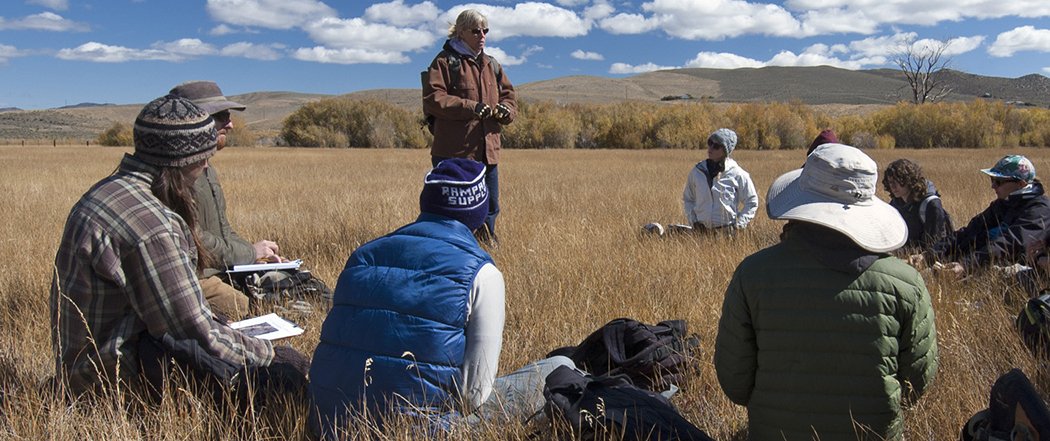Nearly 44 million acres of Nevada rangelands have been invaded by Pinyon Pines and Juniper trees in the past 150 years, reducing valuable habitat for range animals, including the Greater Sage Grouse, which is a candidate for listing as endangered under the Endangered Species Act.
In an effort designed to help the stewards of Nevada's lands make informed decisions, Tamzen Stringham, a professor and nationally recognized rangeland ecologist at the University of Nevada, Reno, travels the open spaces of the 71.5 million acres of the Silver State to catalog and study the rangeland ecosystems. Some of those decisions could be about the habitat for sage grouse, but also pygmy rabbits and other animals that rely on rangelands to survive.
"How we manage these lands to make the birds and other wildlife habitat resistant and resilient to environmental or management impacts is the ultimate goal," she said. "Land managers make the best decisions they can based on current knowledge, and then we look to see if it worked, or if it is a disaster. We quantify these things."
Stringham puts about 25,000 miles on her Ford pickup truck in about three months' time crisscrossing the state to visit hundreds of ecological sites as she and her team catalog site characteristics and responses to various disturbances and management choices so they can prepare state-and-transition models.
"You can't say one thing caused the expansion of Pinyon/Juniper into rangelands," she said. "There are multiple drivers: livestock grazing at settlement, fine fuel reduction, fire suppression, climate change. Fire was a natural driver to keep Juniper and Pinyon in the high rocky places - and a pretty big mechanism.
"With all the drivers there is absolutely a lot of tree expansion, changing the habitat for sage grouse, plus I've been told there have been large reductions in jays and other birds that rely on sagebrush or open woodland systems. The heavy canopy is now a harsh environment for those birds. These birds, and the sage grouse especially, are indicator species for the ecosystems throughout Nevada."
Under contract with the Bureau of Land Management, Stringham, who works in the University's College of Agriculture, Biotechnology and Natural Resources, produces detailed reports for the agency using these state-and-transition models to show how the plant communities respond to disturbances, or non-disturbances.
Her multi-agency team catalogs the soils, elevation, aspect/slope, plant composition, plant productivity and climate at each site. They record disturbances over time, anything from forest or range fires, to grazing impacts and to other man-caused disturbances, including management history. In the last four years they have recorded 586 locations in the state.
The team has several core members, including State Rangeland Management Specialist Patti Novak and soil scientist Paul Blackburn with the Nevada Resource Conservation District; Cody Coombs, Fuel Management Specialist for Ely District, Bureau of Land Management; and rangeland ecologists Devon Snyder and Amanda Wartgow from the University. Dozens of other agency and volunteer members support the team.
The team has spent the past three years studying the 15-million-acre section in the eastern-central portion of the state, known as the Central Nevada Basin and Range. This project produced 310 field "notes" over the course of three field seasons and sixteen weeks of field work.
"This report is about Major Land Resource Area 28B, in the central area of the state, which is a critical habitat for sage grouse, as is the next area on the list, MLRA 26, which covers the area where the bi-state sage grouse live, including the Pine Nut Mountains.
Stringham recently spent four days in the Pine Nut Mountains in Douglas County modeling various ecological sites. The mountain range crosses the border into California. Areas of the Pine Nut Mountains have been mined, grazed and experienced tree removal and tree encroachment from fire suppression since settlement.
"After the ecology has been damaged, there are some things that can be fixed and some that can't - and that is the reality of the world we live in," Stringham said. "The decision to manage the land a certain way, or not, is helped by having the best data available, which can help predict what could happen in the future at each site, and whether or not the site will self-repair or require restoration."
Stringham has completed state-and-transition models for five of the nine rangeland resource areas in Nevada covering more than 35.9 million acres. She just finished MLRA 25, a 9.6-million-acre area in northeastern Nevada and is currently working in two northwest Nevada resource areas, covering an additional 6.7 million acres.
"Nevada is far ahead of the rest of the nation in developing state-and-transition models; most other states are using us as a template," Stringham said. "STMs for northern Nevada will be done by 2017."
"We look at how successful mitigation measures are, such as a seeding for sagebrush or removing trees or cheat-grass," she said. "We determine how successful the work would be utilizing the state-and-transition models. These models allow land managers to assess what they have today, decide if that rangeland condition meets their habitat goals, and, if not, to determine the suite of possible restoration options and the probability of success. This is the type of information that is critical in restoration, especially since 87 percent of lands in Nevada are federally owned and managed."
A faculty member in the Department of Agriculture, Nutrition and Veterinary Science, Stringham provides training on how ecological sites and STMs are developed and improving management of rangelands around the country.
A workshop will be held in Elko the second week of June to teach BLM, Forest Service and other agencies how to use the latest 700-plus page report in developing management plans and restoration treatments for the northeastern Nevada area.
"There will be about 40 land management professionals in the workshop," Stringham said. "It's very popular, and already overfilled. It's critical to their restoration work to have and understand these models."












